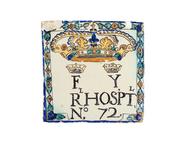





Italian pharmacy vase, polychrome maiolica, 18th century from Castelli or Naples, used for soap plaster (Empiastro Diasapone)
The abbreviated inscription on the jar describes its original contents. The full Latin name Empiastro Diasapone translates into English as “Soap Plaster” or “Soap Poultice”. This refers to a hot poultice which was used to counter pain caused by gout.
It was made from 2 lb (0.9 kg) of olive oil, 1 lb (0.45 kg) of red lead (now known to be highly toxic) and 1/2 lb (0.2 kg) of soap boiled into a soft mass. The soap was then applied externally to the body.
Details
- Category:
- Medical Ceramic-ware
- Collection:
- Sir Henry Wellcome's Museum Collection
- Object Number:
- A632035
- Materials:
- whole, pottery, polychrome maiolica
- Measurements:
-
overall: 160 mm 135 mm, .9kg
- type:
- drug jar



